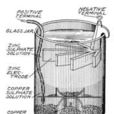重力電池是一種只需一個電解液容器的雙葉原電池。這種電池中,液面分界處充當鹽橋作用,兩種不同電解液通過密度不同而分層,達到了不互溶混合的效果。
基本介紹
- 中文名:重力電池
- 外文名:gravity cell
- 參閱:《瘋狂科學》/<popular science>
原材料,製作步驟,注意事項,反應原理,英文資料,
原材料
硫酸銅,蒸餾水,鎂帶/鎂片/鋅片/鋅電極,粗銅絲/銅片/銅電極,硫酸,燒杯,電線。
製作步驟
1.製備硫酸銅飽和溶液
向裝有硫酸銅晶體的燒杯中加入蒸餾水至固體全部溶解
2.以硫酸銅溶液為下層電解質溶液,加入上層液體
沿燒杯壁緩慢緩慢加入蒸餾水,體積與硫酸銅溶液相仿
3.放入電極
將準備好的電極緩慢放入液體,儘量不要引起液面分層處的液體互相混合,先放銅電極
4.觸發反應
向上層液中滴入數滴硫酸(或其溶液),在上層活潑金屬電極產生起泡後2~5小時電池即完成了激活
注意事項
- 硫酸銅溶液不一定要飽和,但越濃越好。一方面,越濃電解質溶液可使電池內部反應更快,可獲得更大的電流;另一方面,硫酸銅溶液濃度越大密度也越大,可更好保證兩種電解質溶液不互溶。
- 金屬電極的表面積越大越好,這樣反應表面積變大,電流強度隨之變大
- 此電池可供二極體發光
- 當下層硫酸銅溶液隨著反應時間逐漸變稀時可以直接向燒杯中投入大塊硫酸銅晶體補充
- 如果上層活潑電極一直生成氣泡並消耗,可在不使用時拔出此電極
反應原理
(以鋅為例)
硫酸銅溶液中: Cu 2+ + 2e- == Cu
上層水中: 1. H2SO4 + Zn== ZnSO4 + H2 2.Zn - 2e- ==Zn 2+
液面分界處充當鹽橋作用
英文資料
- 1.Pour copper sulfate (the blue granules) over a copper electrode in a glass.
- Fill it with distilled water.
- Add a crow's-foot-zinc electrode, and short-circuit the battery for 24 hours to kick-start the battery reaction.
- Connect to the device of your choice. Yields one volt.
People used to make a lot of things at home. They churned their own butter, cooked food without microwaves, and knitted pairs of socks. Some hundred years ago, people even made their own electricity: DIY batteries powered their doorbells and telegraphs.
Today, batteries meant for heavy use are rechargeable. But how do you get power when there is no grid? Early batteries were designed to be "renewed," which meant replacing or replenishing their chemicals to give them new energy. You´d top them off with then-common general-store items like crow´s-foot zinc, blue vitriol, black oxide of manganese, and caustic soda. (The latter is still available in stores, but now it´s called Drano.)
One particularly photogenic type of battery was known as a "gravity cell," because gravity is what held it together. Typically used to power telephone and telegraph circuits, it consisted of a solution of blue vitriol (known these days as copper sulfate and sold in garden centers for pond treatment) on the bottom and a layer of zinc sulfate on top, kept separate only by their slightly different densities.
At the top, the electrode gives off zinc ions, while at the bottom, copper sulfate is reduced into copper metal. Together these complementary reactions produce just over one volt; string five batteries in series, and you get enough power to run a flashlight or charge an iPod. Any movement disturbs the delicate layers, ruining the battery, but if you´re careful, you can drop in new crystals of blue vitriol as needed, and the battery will run for years.
There is even talk of running electric cars on zinc-air or aluminum-air batteries. Like gravity cells, these types of batteries can be renewed instantly by dumping in more zinc or aluminum, rather than plugging them into a charger for hours on end-which should make for much shorter lines at the corner battery station.

